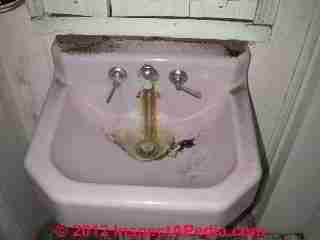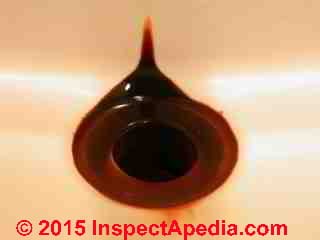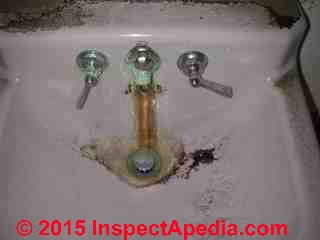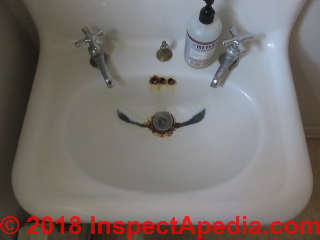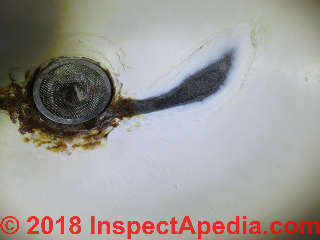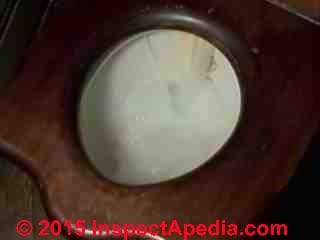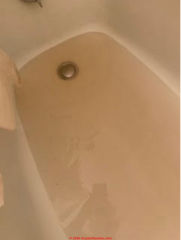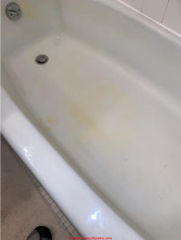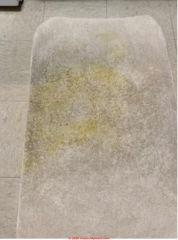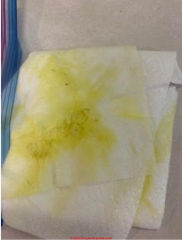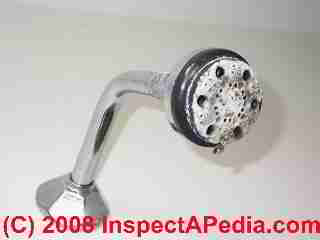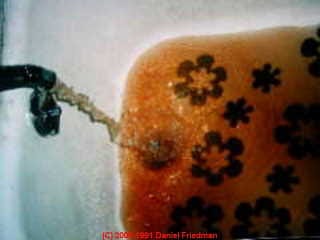 Stain-generating Contaminants in Water
Stain-generating Contaminants in Water
Black, blue, red, white, yellow, green stains from or in water supply: copper, iron, manganese, sulphur & tannins in water; odors & iron/manganese bacteria
- POST a QUESTION or COMMENT about chemicals & contaminants in the water supply that cause stains in or on plumbing fixtures, buildings or laundry
Stains & odors in the water supply:
Here we explain of the causes & sources of stains traced to the building water supply or supply piping: what are the sources of black, brown, green, red, yellow, or other stains in or caused by the building water supply, piping, water treatment equipment, water softener, water filter, or water piping.
Some of these staining contaminants in the water supply can explain water odors such as smells of sewage, fuel oil, even cucumbers. And some of these water stainers can tell us something about the need to protect the water piping system from corrosive or aggressive water.
InspectAPedia tolerates no conflicts of interest. We have no relationship with advertisers, products, or services discussed at this website.
Stains from the Water Supply & Colors of Water
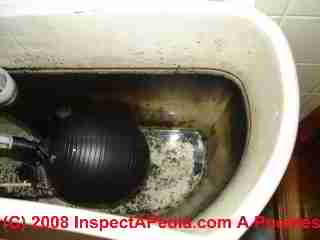 Several common chemicals, including minerals familiar to most homeowners can colour the water supply or produce stains on plumbing fixtures, in the laundry, in the water softener, and on clothing.
Several common chemicals, including minerals familiar to most homeowners can colour the water supply or produce stains on plumbing fixtures, in the laundry, in the water softener, and on clothing.
This article summarizes these water stain sources and summarizes the typical filters or water treatment methods used to correct these conditions.
[Click to enlarge any image]
Article Contents
Black Stains on Plumbing Fixtures, Laundry, Other Surfaces Traced to Water Contaminants: Sulphur, Manganese or Particulate Sources
The black stains and crud in the toilet tank shown at left are most likely due to an unusually high level of sulphur in the water supply to the building where this toilet is installed. The water also smelled like "rotten eggs" adding weight to that hypothesis.
Photo courtesy of Kingston New York home inspector Arlene Puentes (seeReferences or Citations ).
Look for sulphur in the water supply as well as organic debris, silt, mud, or other inorganic contaminants. Also look for black sulphur deposits in water piping that ultimately appears as debris in the water supply.
Treatments for Iron or Manganese or Iron/Manganese bacteria in the Water System
and also
see WATER TREATMENT EQUIPMENT CHOICES
Manganese contamination in the water supply
A second common source of black stains and fine particulates in water supply systems (or in the toilet cistern shown above) is manganese. Manganese enters the water supply in areas where ground water or the aquifer is acidic, fostering the dissolution of manganese from manganese-bearing rock and soil through which the water passes.
The manganese level in a building water supply may be made more apparent (as black sludge or deposits or as dark or black stains on laundry) when acidic, manganese-bearing water interacts with organic matter that is also in the water supply.
Thus we're more likely to see higher levels of black manganese staining in buildings supplied by water from a dug well, shallow well or other shallow water source.
As we discuss below
at RED STAINS from WATER SUPPLY, Gallianella bacteria that can metabolize manganese may form a black slime or sludge layer in toilet tanks, water tanks, piping and well interiors. Manganese-loving bacteria may also be an odor source in the water supply.
A BART, or Biological Activity Reaction Test can determine if this type of bacteria is present in your water supply.
On occasion we find black debris in the water supply from other sources including organic debris and even damaged water pump impeller parts. But if the water smells like sulphur, that's the probable cause.
Manganese Contaminant Limits in Drinking Water
- In the U.S. drinking water regulations set by the U.S. Environmental Protection Agency (US EPA) recommends maximum contaminant level of 0.05 mg/L of manganese in drinking water.
Treatments for Iron or Manganese or Iron/Manganese bacteria in the Water System
- A chlorinator or water chlorine injection treatment system (a chemical feed system), usually combined with a charcoal filter for water treatment may be functional as a water disinfection method (to treat bacterial contaminants).
Chlorination also can remove high concentrations of ionic iron, ionic manganese and tannins as well as organic contaminants that left alone contribute to iron/manganese loving bacterial problems in the water supply system.
See CHLORINATORS & CHARCOAL FILTERS for details. - For additional methods that can remove manganese from the water supply
see RED STAINS from WATER SUPPLY
Blue Stains from Water or Blue-Colored Water Supply
Question: what is making our water look blue?
2018/06/18 Janelle said:
I have a glass lined water pressure tank from Sears. Will it cause our water to turn blue or is it from a different problem. Tastes ok and it does not smell? Any help on this would be good.
Reply:
Do you have copper piping in your building? There could be a combination of corrosive water and copper pipes.
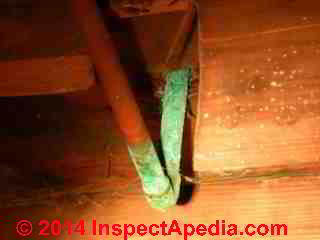 While copper pipe internal corrosion can add a blue hue to drinking water, usually copper pipe corrosion seen on the pipe exterior is dominated by green.
While copper pipe internal corrosion can add a blue hue to drinking water, usually copper pipe corrosion seen on the pipe exterior is dominated by green.
Also see our notes on water staining contaminants starting
at WATER STAINING CONTAMINANTS
Reader follow-up:
Janelle said:
No we do not have copper pipes, we do live in Texas and praying for rain .I am not sure if our well is low and may be copper deposits in the underground springs.
I guess a good gully washer would answer that. I just don't know if too much to drink is bad for us or the animals.
Reply: Reasons that a water supply may turn blue or look blue in a glass of water
More on reasons that a water supply may turn blue or look blue in a glass of water
Janelle
Thanks for the follow-up.
 The most-commonly-cited explanation of blue staining and blusih colored water is the combination of acidic (low pH) water and copper piping. Copper in the water supply itself is uncommon but your supposition is certainly possible.
The most-commonly-cited explanation of blue staining and blusih colored water is the combination of acidic (low pH) water and copper piping. Copper in the water supply itself is uncommon but your supposition is certainly possible.
It is possible that other water contaminants such as other minerals or algae (more often a reddish brown color but possibly green or greenish blue color) might also give you water a blue color.
- The U.S. EPA enforceable action level for copper in drinking water 1.3 mg/L - in order to prevent adverse health effects.
- The U.S. EPA's maximum contaminant level of copper in drinking water (non-enforceable) is set at 1.0 mg/L out of concern for aesthetics rather than health concerns.
US EPA: www.epa.gov/dwstandardsregulations/secondary-drinking-water-standards-guidance-nuisance-chemicals
You might want your water tested, first to confirm that the stain is from copper and not algae or some other contaminant and second to determine the level of contaminant to let you decide if the color is just aesthetic or if it is a possible health concern.
Tell us where you are located in Texas.
Some Texas water sources are reported to have copper but often well below the EPA standard.
- California: COLOR OF WATER, FACT SHEET [PDF] CA State Water Resources Control Board, Clean Water Team, Fact Sheet 3.1.5.9 retrieved 2018/06/19, original source: www.waterboards.ca.gov/water_issues/programs/swamp/docs/cwt/guidance/3159.pdf
Transparent water with a low accumulation of dissolved materials appears blue and indicates low productivity.
Dissolved organic matter, such as humus, peat or decaying plant matter, can produce a yellow or brown color.
Some algae or dinoflagellates produce reddish or deep yellow waters.
Water rich in phytoplankton and other algae usually appears green.
Soil runoff produces a variety of yellow, red, brown and gray colors.
tannins and lignins [from plants], ... give water a tea color - Dallas News reported up to 3 ppm copper in water in some schools in Dallas (January 2017) - retrieved 2018/06/19, original source: www.dallasnews.com/news/education/2017/01/20/seven-dallas-isd-schools-elevated-lead-copper-water
- Sulphur Springs TX: ANNUAL 2014 DRINKING WATER QUALITY REPORT [PDF] ) - retrieved 2018/06/19, original source: www.sulphurspringstx.org/departments/docs/2015CCR.pdf om 2013 found 0.407 (presumablhy mg/l) of copper
- www.sulphurspringstx.org/departments/docs/2015CCR.pdf
Blue Lake or River Water
Interestingly, when you look at a body of water like a lake, if the lake looks particularly blue, usually that means that the lake is LOW in algae and sediment.
Algae and sediments in a body of water generally reduce the absorption of longer wavelengths of light and thus may shift a lake color from blue (generally clean water) towards red, brown, or green.
Brown Stains on Plumbing Fixtures or Fabrics Traced to Water Supply Contaminants
Stains on plumbing fixtures may be due to simply poor housekeeping or to contaminants in the water supply, or as shown on the porcelain-coated tub and on the pink cast iron sink above, a combination of the two.
At the sink a protracted drip at the faucet left brown stains on the fixture surface.
Brown colored water supply
Several contaminants can make a water supply look brown in color, including tannins and algae.
From California: COLOR OF WATER, FACT SHEET [PDF] CA State Water Resources Control Board, Clean Water Team, Fact Sheet 3.1.5.9 retrieved 2018/06/19, original source: www.waterboards.ca.gov/water_issues/programs/swamp/docs/cwt/guidance/3159.pdf
Some algae or dinoflagellates produce reddish or
deep yellow waters.
Water rich in phytoplankton and other algae usually appears green.
Soil runoff produces a variety of yellow, red, brown and gray colors.
tannins and lignins [from plants], ... give water a tea color
Also see RED STAINS from WATER SUPPLY
Green Stains on Plumbing Fixtures or Fabrics Traced to the Water Supply or Water Piping: Copper in Water, Corrosive water
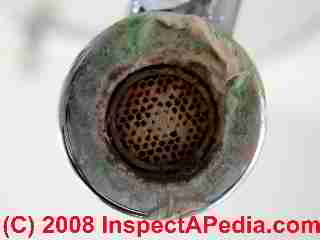 Where the building's water color has a greenish or bluish caste, look for water with a high corrosivity index, copper water supply piping, or copper in the water source itself.
Where the building's water color has a greenish or bluish caste, look for water with a high corrosivity index, copper water supply piping, or copper in the water source itself.
Copper in the water supply tends to leave a greenish-blue stain on white surfaces such as porcelain sinks or tubs, or beneath shower heads, particularly where there has been a drippy faucet or shower head.
The green stains on the faucet mouth shown below (left) may be due to corrosive water and the white deposits are almost certainly a calcium or similar mineral deposit characteristic of water high in mineral content.
The level of copper that may be absorbed into water from copper supply piping depends on the corrosivity index of the water supply.
Some literature describes this as "aggressive water" meaning that the water chemistry can aggressively or powerfullly-dissolve metals from the piping system.
Water that is high in Co2 (carbon dioxide) or O2 (oxygen) or water that has a high acid due to having passed through rock high in natural acids is corrosive and tends to dissolve brass and copper pipes and plumbing fixtures.
Details are at CORROSIVITY or ACIDITY of WATER.
Methods for Treating Copper Building Pipes Producing Green Stains in Water or on Fabrics & Fixtures
- Chemical Coating systems:
a chemical feeder / coating system using sodium silicates along with polyphosphates is used to protect copper water supply piping that is being attacked by a water supply with a high oxygen content.
A polyphosphate feed system may be installed on a building where the water supply is green due to dissolved copper leached from copper piping and / or where green stains are showing up on plumbing fixtures or on fabrics laundered in water from such a water system.
Green colored water supply
Algae is a common cause of greenish-colored water from lakes, rivers, streams, and occasionally a well or spring or private water supply.
From California:
- COLOR OF WATER, FACT SHEET [PDF] CA State Water Resources Control Board, Clean Water Team, Fact Sheet 3.1.5.9 retrieved 2018/06/19, original source: www.waterboards.ca.gov/water_issues/programs/swamp/docs/cwt/guidance/3159.pdf
Transparent water with a low accumulation of dissolved materials appears blue and indicates low productivity.
Water rich in phytoplankton and other algae usually appears green.
Red Stains on Plumbing Fixture or Fabrics: Iron in Water - red-yellow slime, clogs, diesel oil odors, sewage odors
Red stains on plumbing fixtures from iron in the water supply
Iron in water is a common cause of red stains on clothes as well as red deposits on sinks or tubs where there have been dripping faucets.
Iron is common in the earth in most areas and can be dissolved by and thus present in water supplies.
In buildings where water supply piping is made of iron or steel, as those pipes age and rust red stains in the water supply or on the laundry may be due to the pipes even if iron is not present at high levels in the incoming water supply.
The red stains produced by iron in the water supply are deposits of either ionic ferrous iron (produced as iron in the water reacts with oxygen also in the water) or of ferric iron, a more stable compound more likely to be the actual component of red stains you see.
Red stains on plumbing fixtures from leaks & corrosion
Watch out: red "stains" on old plumbing fixtures such as the sink shown above may not be due to iron in the water but rather to protracted leaking.
If the water supply is a bit corrosive, the combination of faucets left dripping for long periods and the passage of water over the surface of even a heavy porcelain-coated cast-iron sink such as this one can completely wear-away the porcelain, exposing the steel or cast-iron below.
I think these sink faucets must have dripped or run for decades in this older Poughkeepsie NY home. The result is a ruined sink.
Also see LEAK TYPES, WATER SUPPLY or DRAIN PIPES
Red Stains on Plumbing Fixtures from Organics or from Bacteria
Red iron-related stains may also come from decaying organic materials in the water supply or from "iron bacteria: (Gallianella bacteria) that digest ferrous iron in the water supply. Iron-bacteria are more commonly found in water from dug wells or shallow wells in from surface water.
The iron-eating bacteria are not themselves a health hazard but the presence of this ferro-philic bacteria in your water supply may explain unpleasant odors (and may occur simultaneously with sulphur in the water supply).
The smell from iron-bacteria in water is often described as a "fuel oil" odor and some sources reported describe it as a "cucumber odor in water" or as sewage. It's that "sewage smell" that can also be confused with the "rotten egg" smell of sulphur-contaminated water supplies.
Iron deposits that accumulate on a foot valve, well screen, or on a driven point well tip can clog the water entry points and thus reduce well yield.
The Water Quality Association in the U.S. points out that
"Harmless organic compounds from decaying vegetation in water also may react with iron to cause severe staining. 'Iron bacteria,' which use iron in their metabolic processes, may also cause problems [with red stains on fabrics or fixtures]." - WQA (undated).
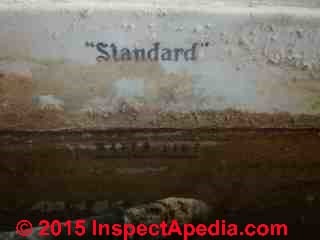 High iron levels in water passing through rusty, corroding iron or steel pipes may correlate also with corrosive or aggressive water chemistry that speeds the corrosion process.
High iron levels in water passing through rusty, corroding iron or steel pipes may correlate also with corrosive or aggressive water chemistry that speeds the corrosion process.
Finally, the presence of a yellow or orange-coloured slime inside a water storage tank (no you never there) or in a toilet tank (where you can look) is a good indicator that your water supply contains iron-loving bacteria.
It's possible that the pink crust in the toilet tank shown at left is a left-over from a combination of high mineral content and high iron content in the water supply to the building where this toilet was installed.
For dealing with iron-bacteria, try disinfecting the well as well as the building water piping and water tank.
However just shocking the well may be little more than a "band-aid" cure since the disinfectant may be unable to kill off thick layers of iron-bacterial slime in the well or piping system.
See WELL CHLORINATION SHOCKING PROCEDURE and increase the wait time before flushing out the chlorine disinfectant.
Iron Contaminant Limits in Drinking Water
- In the U.S. the U.S. Environmental Protection Agency's drinking water regulations recommend that the level of iron in drinking water be kept below 0.3 mg/L.
Methods for Treating or Removing Iron & Manganese in the Water Supply
- Aeration systems
can reduce low levels of manganese or iron in the water supply if the incoming water temperatures are sufficiently warm, if the water is at a sufficiently high pH, and if the level of iron and manganese in the water supply is not high. - A chlorinator or water chlorine injection treatment system
(a chemical feed system), usually combined with a charcoal filter for water treatment may be functional as a water disinfection method (to treat bacterial contaminants).
Chlorination also can remove high concentrations of ionic iron, ionic manganese and tannins as well as organic contaminants that left alone contribute to iron/manganese loving bacterial problems in the water supply system.
See CHLORINATORS & CHARCOAL FILTERS for details. - Calcite media filters:
Calcite media water treatment filters adjust the pH of the water to make it less corrosive (when the starting water pH is at a pH of 5.5 or less) and also to precipitate ionic iron or ionic magnesium from the water supply so that it can be captured by the water filtration system.
Calcite media filters are used principally when water staining that shows up in the water itself or on plumbing fixtures or on laundered fabrics is itself traced to rusty or corroded water mains or in-building water supply pipes (steel or iron piping).
See CORROSIVITY or ACIDITY of WATER - Iron & Manganese Filters:
iron "reduction" filters are used to remove iron and manganese where the water supply is already soft (you don't want to install a water softener) and where they can be effective: that is when the water supply pH is above 6.8 and when the iron and manganese levels combined add up to less than 10 mg/L of these substances.
The iron filter absorbs ionic manganese and iron and depending on filter design may oxidize it further.
See WATER FILTERS - SEDIMENT & IRON for more about removing non-bacterial iron contaminants. - Water softeners & conditioners
can remove modest iron and manganese levels: since stain materials can accumulate in the water softener or its brine tank.
Where there are low tannin contributions to the water supply (yellow staining) a water softener employing a special anion-exchange water softener resin is capable of removing low tannin concentrations in the water.
See WATER SOFTENERS & CONDITIONERS
and see WATER SOFTENER CLEANING & SANITIZING
where we also discuss IRON & SEDIMENT REMOVAL
and see WATER SOFTENER IRON & SEDIMENT REMOVAL - Sequestration by Chemical Feed for Water Purification:
very high concentrations of iron in the water supply may be treated by the addition of food-grade polyphosphate to the water.
The polyphosphate compounds, in a chemical reaction, "sequester" that is isolate and separate iron (Fe) molecules which keep the iron in solution in the water supply.
This process prevents iron from separating out of the water, presumably until after the high-iron-content water has been discharged as wastewater.
All of the iron or manganese water treatment methods above are discussed further
at WATER TREATMENT EQUIPMENT CHOICES
Yellow Stains on Plumbing Fixtures Traced to Water Contaminants: Tannins
The vertical yellow stain trace to the left of the water entering this antique wood-seated commode may be due to tannins in the water supply.
Tannins can impart a yellow hue to water and may leave yellow stains on fabrics washed in tannin-laden water.
Particularly where running water from protracted leaks or drips has been present tannins can produce a yellow stain on the porcelain surface of a sink toilet, or tub or on other china surfaces.
Tannins are an aesthetic issue, not a health issue in the building water supply and are typically found in water sources filtered through peaty soils such as those in the following areas:
In Canada tannins are common in the Maritime Islands and in some areas of B.C.
In the U.S. tannins are commonly found in water supplies around the Great Lakes (see Gooseberry Falls north of Two Harbors MN where the water runs brown). In U.S. water supplies in the Southeast, Northwest, and in portions of New England tannins are also common in water.
Question: what is causing these yellow stains on our plumbing fixtures
[Click to enlarge any image]
I hope that you can help me determine what caused these yellow stains on my towels, bathmat, duvet cover, sheet, bathtub, and kitchen floor. I believe that the chemical came from a tap in my shower.
I live on the 25th floor of a 37 story high rise in NYC. The building was constructed in 1974.
Yesterday, Saturday December 28th , I noticed that my towels, bathmat, duvet cover, sheet, bathtub, and kitchen floor all had bright yellow stains.
I have attached photos that will show you what I found and perhaps give you some idea of what the chemical might be.
The first photo shows the yellow material that came up when I used a paper towel to clean the bathroom floor using a vinegar/water 1;1 solution.
I wasn’t thinking at the time about doing a chemical analysis and so used vinegar diluted 1:1 with water. I would greatly appreciate your ideas about what this chemical might be.
I questioned whether this might be coming from my body, but have not used a different soap, taken any new medications or used sunscreen and do not see any evidence of this on my skin.
I think there must have been something in the water that caused this staining. These stains came to be on the duvet cover and sheet because typically when I come out of the shower, I dry off mostly with a towel, then sit on the bed on the duvet cover to get dressed.
If I feel I’m still not completely dry, I will flip up the duvet cover and sit on the top sheet.Janet Handal
I think that vinegar helps remove the stain. I was able to get it off my bath tub and kitchen floor scrubbing with Ajax cleaner with bleach.
Do you know if a chemical test on the paper towel would determine what it is even though it now has vinegar as well? Do you know where I might get this tested? I have put it in a plastic bag to maintain the moisture.
The last picture is one taken about a month ago. From time to time we have “brown water”as the picture shows. Not sure if they are related. Have not tested brown water condition, but think I should. Do you have any suggestions about which company’s test I should use? I am president of our apartment complex and represent the 3500 people living here.
Thank you. - Anonymous by private email 12/29/2019
Reply:
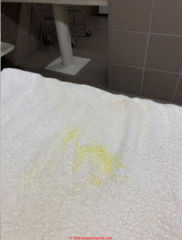 Well thank you for the interesting question and photos. Frankly I've never seen such bright yellow stains like that occurring simply traced to a water supply.
Well thank you for the interesting question and photos. Frankly I've never seen such bright yellow stains like that occurring simply traced to a water supply.
The most-common cause of such staining is from tannins in the water supply. Tannins can produce both yellow and brown stains such as we see in your photos.
But it's also possible that there's a combination of a contaminant in the water in a chemical reaction going on.
Very often darker brown or reddish brown stains are from rust. But that bright yellow and brown without red rust tones argues for a tannin problem.
I suggest having your water supply tested including
- For tannins
- For Iron
- For other yellow-staining contaminants that your local water test lab might suggest.
. Let's both do some research and report back what we can find.
There is, as you'll read below, equipment that can remove tannins and iron from the water supply.
Methods for Removing Tannins from the Building Water Supply System
- Water softeners & conditioners
can remove modest iron and manganese levels: since stain materials can accumulate in the water softener or its brine tank.
Where there are low tannin contributions to the water supply (yellow staining) a water softener employing a special anion-exchange water softener resin is capable of removing low tannin concentrations in the water.
See WATER SOFTENERS & CONDITIONERS
White Stains on Plumbing Faucets, Fixtures, Shower Heads or on Plumbing Fixtures: hard water, calcium, other minerals
See WATER HARDNESS: HOW TO DETECT
also
See EFFLORESCENCE SALTS & WHITE DEPOSITS
...
Continue reading at WATER TREATMENT EQUIPMENT CHOICES or select a topic from the closely-related articles below, or see the complete ARTICLE INDEX.
Or see these
Recommended Articles
- STAIN DIAGNOSIS on BUILDING INTERIORS
- WATER SOFTENERS & CONDITIONERS
- WATER TREATMENT EQUIPMENT CHOICES
Suggested citation for this web page
WATER STAINING CONTAMINANTS at InspectApedia.com - online encyclopedia of building & environmental inspection, testing, diagnosis, repair, & problem prevention advice.
Or see this
INDEX to RELATED ARTICLES: ARTICLE INDEX to WATER TREATMENT SYSTEMS
Or use the SEARCH BOX found below to Ask a Question or Search InspectApedia
Ask a Question or Search InspectApedia
Try the search box just below, or if you prefer, post a question or comment in the Comments box below and we will respond promptly.
Search the InspectApedia website
Note: appearance of your Comment below may be delayed: if your comment contains an image, photograph, web link, or text that looks to the software as if it might be a web link, your posting will appear after it has been approved by a moderator. Apologies for the delay.
Only one image can be added per comment but you can post as many comments, and therefore images, as you like.
You will not receive a notification when a response to your question has been posted.
Please bookmark this page to make it easy for you to check back for our response.
Our Comment Box is provided by Countable Web Productions countable.ca
Citations & References
In addition to any citations in the article above, a full list is available on request.
- Thanks to Arlene Puentes for the photograph of a toilet tank with sulphur bacteria and debris showing as black goop. Arlene Puentes, a licensed home inspector, educator, and building failures researcher in Kingston, NY. Photographs © Arlene Puentes 2006 All Rights Reserved. Text © Daniel Friedman Arlene Puentes 2008 All Rights Reserved
- Arlene Puentes [Website: www.octoberhome.com ] , an ASHI member and a licensed home inspector in Kingston, NY, and has served on ASHI national committees as well as HVASHI Chapter President. Ms. Puentes can be contacted at ap@octoberhome.com
- NRDC: Natural Resources Defense Counci, 40 West 20th Street, New York, NY 10011 USA Tel: (212) 727-2700, Website: http://www.nrdc.org/ Email: nrdcinfo@nrdc.org
- NSF International, P.O Box 130140, 789 N. Dixboro Road, Ann Arbor, MI 48105, USA. NSF has offices world wide. USA Tel: 1-800-673-6275, Website: http://www.nsf.org/ Email: info@nsf.org or for standards questions: standards@nsf.org
- WQA Water Quality Association, International Headquarters & Laboratory, 4151 Naperville Road, Lisle, IL 60532-3696 USA, Tel: 630-505-0160, Website: http://www.wqa.org/
- Principles and Practice of Disinfection, Preservation and Sterilization (Hardcover)
by A. D. Russell (Editor), W. B. Hugo (Editor), G. A. J. Ayliffe (Editor), Blackwell Science, 2004. ISBN-10: 1405101997, ISBN-13: 978-1405101998.
"This superb book is the best of its kind available and one that will undoubtedly be useful, if not essential, to workers in a variety of industries. Thirty-one distinguished specialists deal comprehensively with the subject matter indicated by the title ... The book is produced with care, is very readable with useful selected references at the end of each chapter and an excellent index. It is an essential source book for everyone interested in this field. For pharmacy undergraduates, it will complement the excellent text on pharmaceutical microbiology by two of the present editors."
The Pharmaceutical Journal: "This is an excellent book. It deals comprehensively and authoritatively with its subject with contributions from 31 distinguished specialists. There is a great deal to interest all those involved in hospital infection ... This book is exceptionally well laid out. There are well chosen references for each chapter and an excellent index. It is highly recommended." The Journal of Hospital Infection.: "The editors and authors must be congratulated for this excellent treatise on nonantibiotic antimicrobial measures in hospitals and industry ... The publication is highly recommended to hospital and research personnel, especially to clinical microbiologists, infection-control and environmental-safety specialists, pharmacists, and dieticians."
New England Journal of Medicine: City Hospital, Birmingham, UK. Covers the many methods of the elimination or prevention of microbial growth. Provides an historical overview, descriptions of the types of antimicrobial agents, factors affecting efficacy, evaluation methods, and types of resistance. Features sterilization methods, and more. Previous edition: c1999. DNLM: Sterilization--methods. - Handbook of Disinfectants and Antiseptics, Joseph M. Ascenzi (Editor), CRC, 1995, ISBN-10: 0824795245 ISBN-13: 978-0824795245 "The evaluation of chemical germicides predates the golden age of microbiology..." -
This well-focused, up-to-date reference details the current medical uses of antiseptics and disinfectants -- particularly in the control of hospital-acquired infections -- presenting methods for evaluating products to obtain regulatory approval and examining chemical, physical, and microbiological properties as well as the toxicology of the most widely used commercial chemicals. - When Technology Fails, Matthew Stein, Chelsea Green Publisher, 2008,493 pages. ISBN-10: 1933392452 ISBN-13: 978-1933392455, "... how to find and sterilize water in the face of utility failure, as well as practical information for dealing with water-quality issues even when the public tap water is still flowing". Mr. Stein's website is www.whentechfails.com/
- "The Stainers", (undated pamphlet), Water Quality Association, 4151 Naperville Rd., Lisle IL USA 60532, Tel: 6309-505-0160, Website: www.wqa.org
- Water Source Company, 1234 Route 9, Wappingers Falls, NY 12590, Tel: 888-928-3783, Website: thewatersource.com
- In addition to citations & references found in this article, see the research citations given at the end of the related articles found at our suggested
CONTINUE READING or RECOMMENDED ARTICLES.
- Carson, Dunlop & Associates Ltd., 120 Carlton Street Suite 407, Toronto ON M5A 4K2. Tel: (416) 964-9415 1-800-268-7070 Email: info@carsondunlop.com. Alan Carson is a past president of ASHI, the American Society of Home Inspectors.
Thanks to Alan Carson and Bob Dunlop, for permission for InspectAPedia to use text excerpts from The HOME REFERENCE BOOK - the Encyclopedia of Homes and to use illustrations from The ILLUSTRATED HOME .
Carson Dunlop Associates provides extensive home inspection education and report writing material. In gratitude we provide links to tsome Carson Dunlop Associates products and services.



